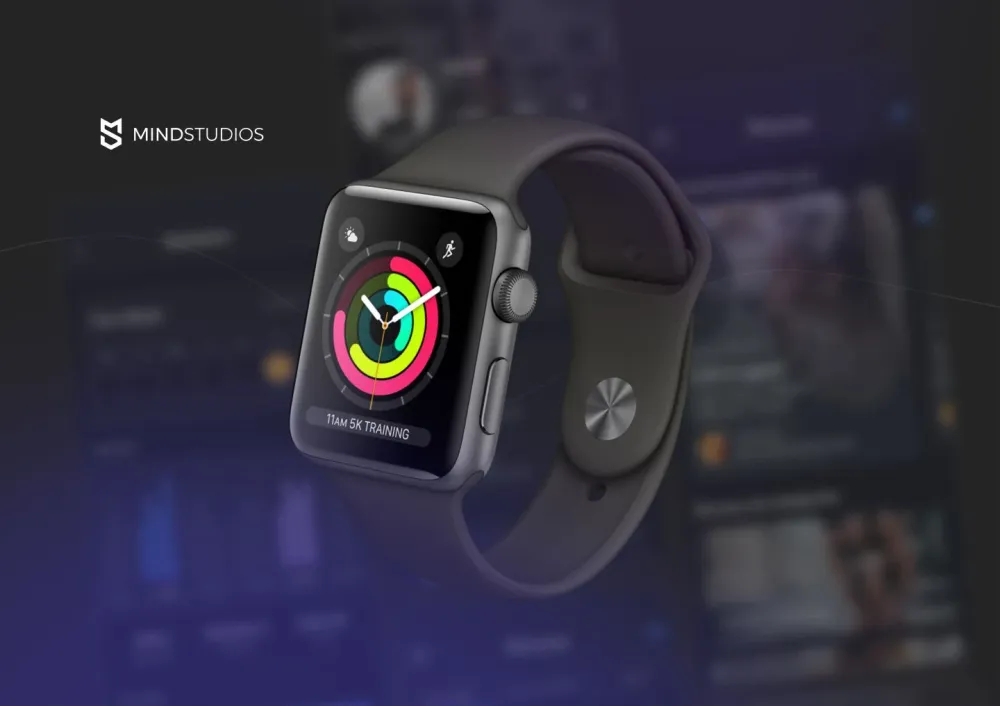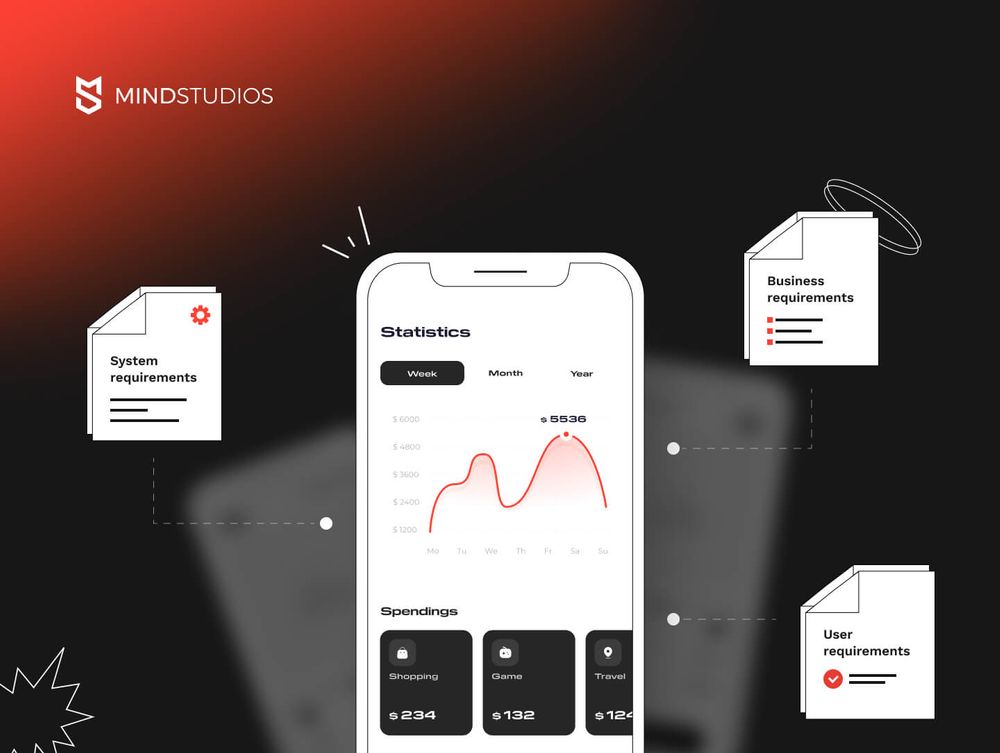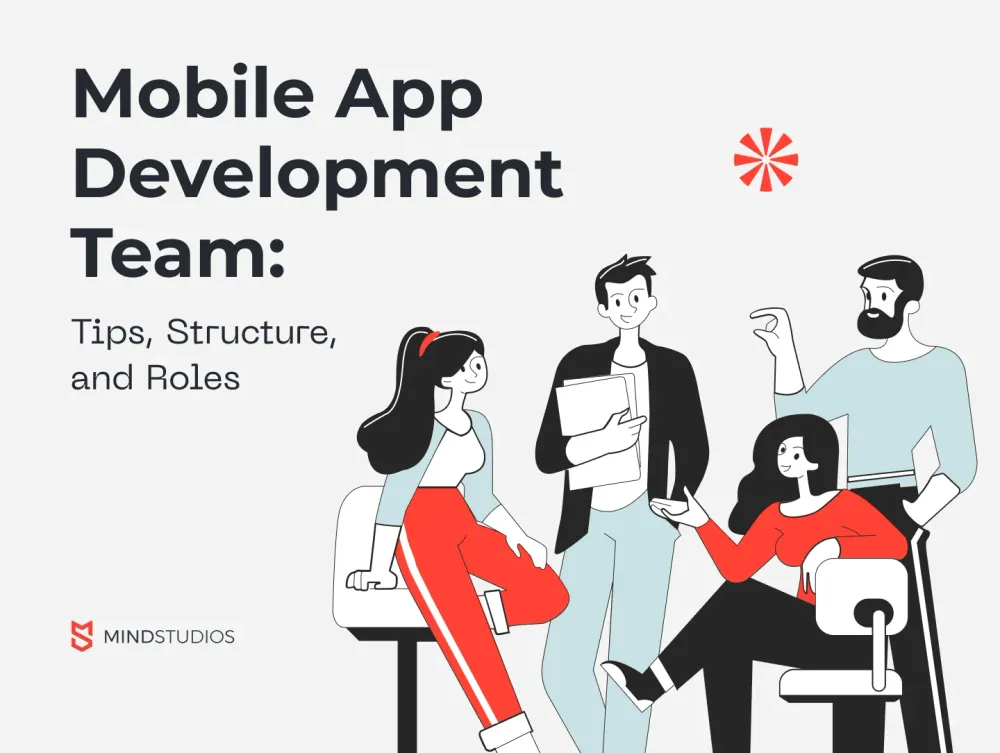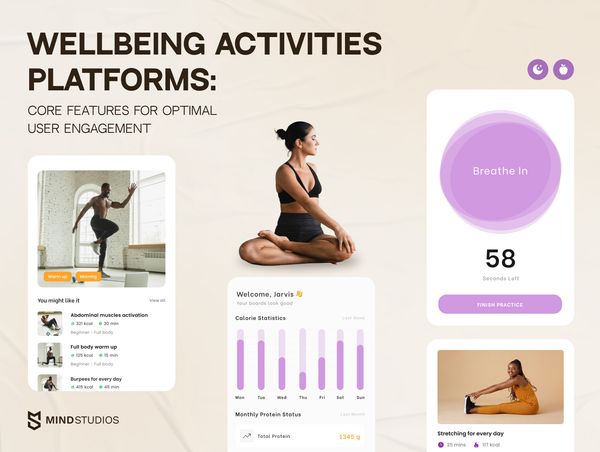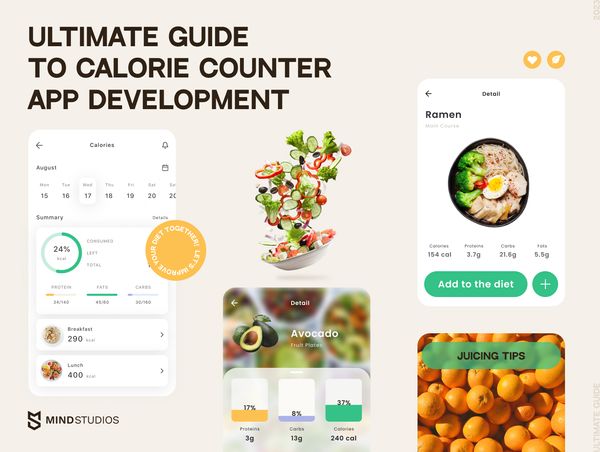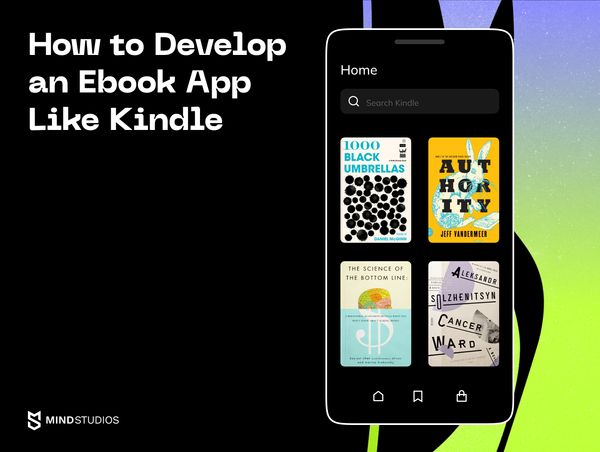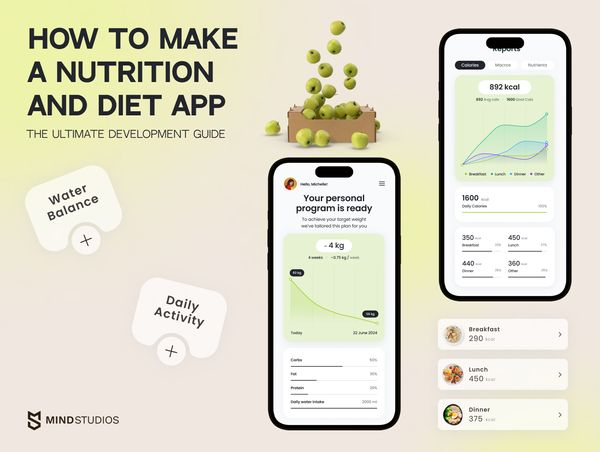
Highlights:
- With more people prioritizing healthy living, the demand for tools that help better manage diet and nutrition has surged.
- Apps that offer a comprehensive approach and are rich in valuable features are in particular demand.
- The diet and nutrition apps market grows annually, making investing in developing such apps a wise and timely decision.
More and more people around the world slowly realize that healthy eating is a crucial part of living a fulfilled, happy, and healthy life. Such global awareness has spurred a significant rise of demand for diet and nutrition app development.
Today, its market keeps steadily growing and is expected to reach $8.29 billion by 2028. If you are considering tapping into this lucrative sector, there’s no better time than now.
But how to develop a diet and nutrition app?
At Mind Studios, we are specializing in turning market opportunities into successful projects. With vast experience in diet nutrition app development , we make sure that your apps are not just feature-rich but meet all constantly changing needs of the health-conscious users.
Just take a look at the feedback Envol, a comprehensive wellness app developed by Mind Studios, received by its users.
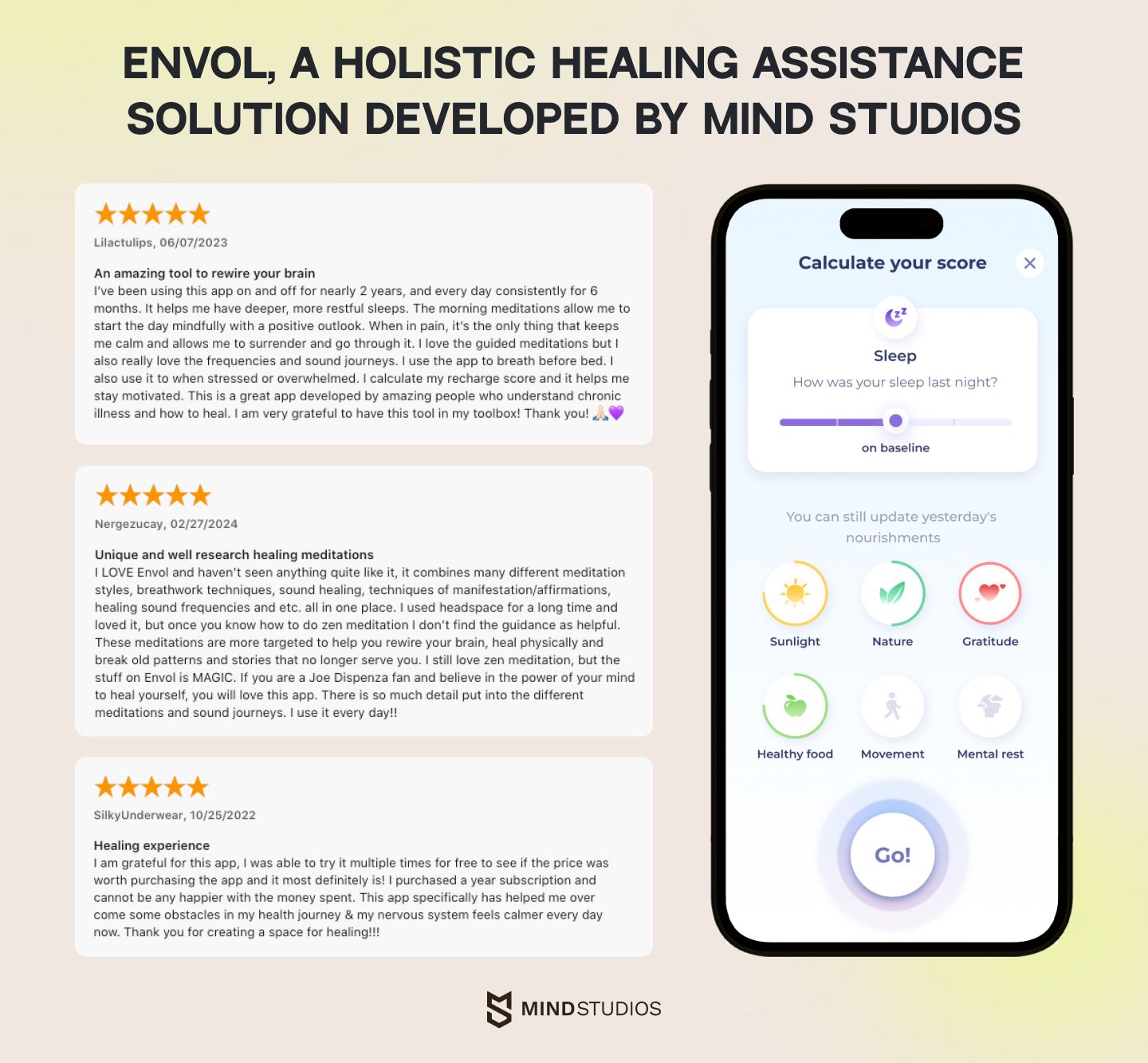
Contact us to be backed by a team that will transform your vision into a successful diet and nutrition app.
Where to start your diet and nutrition app development
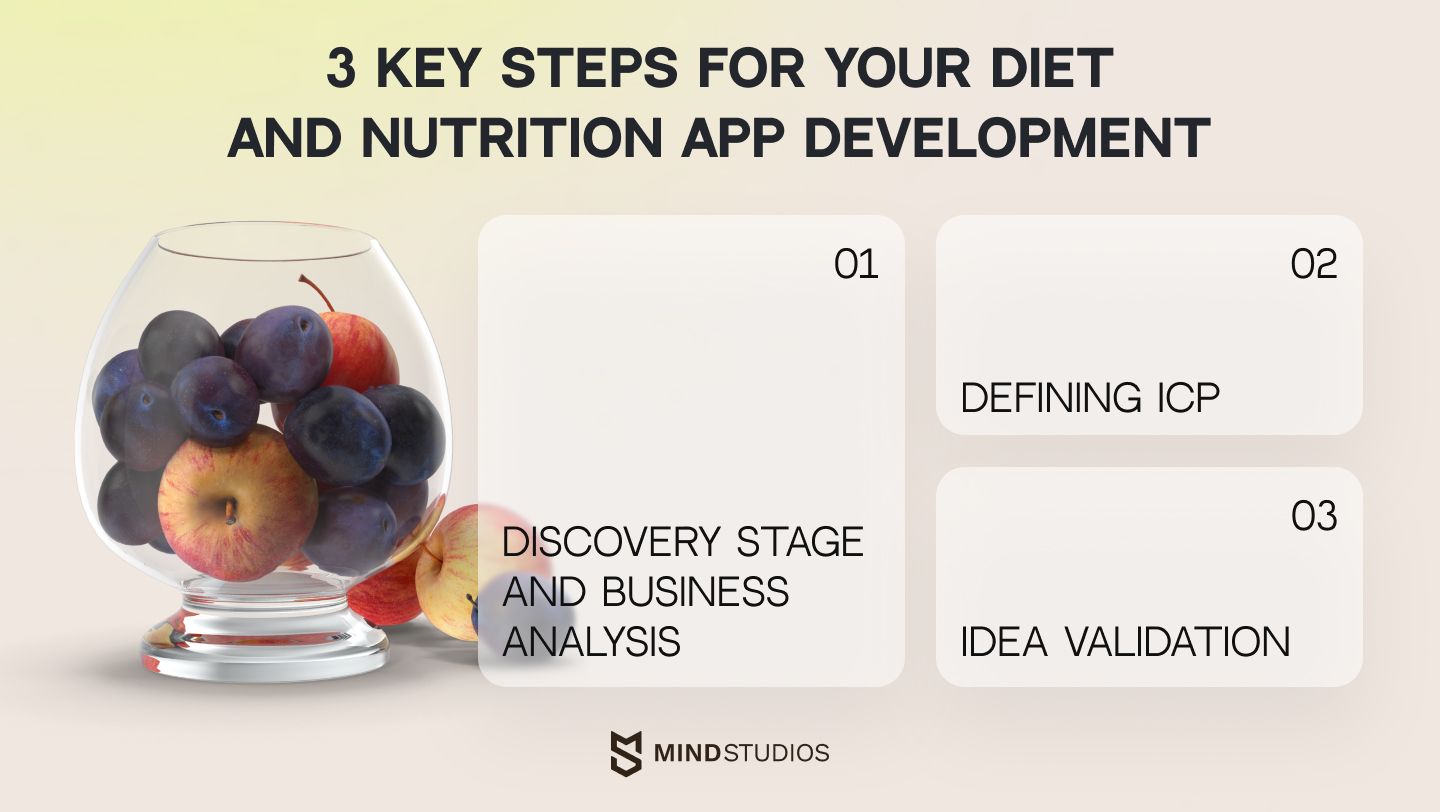
So, you decided to build a diet and nutrition app and are wondering how to make a nutrition app that will be successful.
We’ve got you.
To ensure the project’s success from the outset, we highly recommend leveraging the following steps before starting the actual diet and nutrition tracking app development:
Discovery stage and business analysis
This initial stage helps align your vision with practical aspects of diet and nutrition app development. It is when our team deeply engages with your app idea and explores its feasibility and the best strategy for its implementation. It's also exactly when we explore the potential challenges you may face and their solutions.
Once we lay the foundation, our business analyst takes over to provide you with a comprehensive IT consultancy to mitigate investment risks and make sure your app meets the needs of potential users.
For example, when our clients Julie and Tim first approached us, they initially wanted to improve their existing Envol app for Android, which had some major issues with audio playback for guided meditations. However, our tech analysis revealed that their app lacked the necessary functionality, so we recommended a complete rebuild to meet their needs better and ensure future scalability. And it worked for the better.
Defining the ICP
Understanding your Ideal Customer Profile (or simply ICP) is a vital step that helps tailor your app's functionality to meet the specific needs of the users of your target market segment. This also helps align both the app's design and features with users' expectations.
When working on the Attentive Care app, we created four user personas, each with its own specific profile: pain points, goals, wants, fears, needs, and bio. This helped us a lot with finding which features every persona needs and adding them to the app.
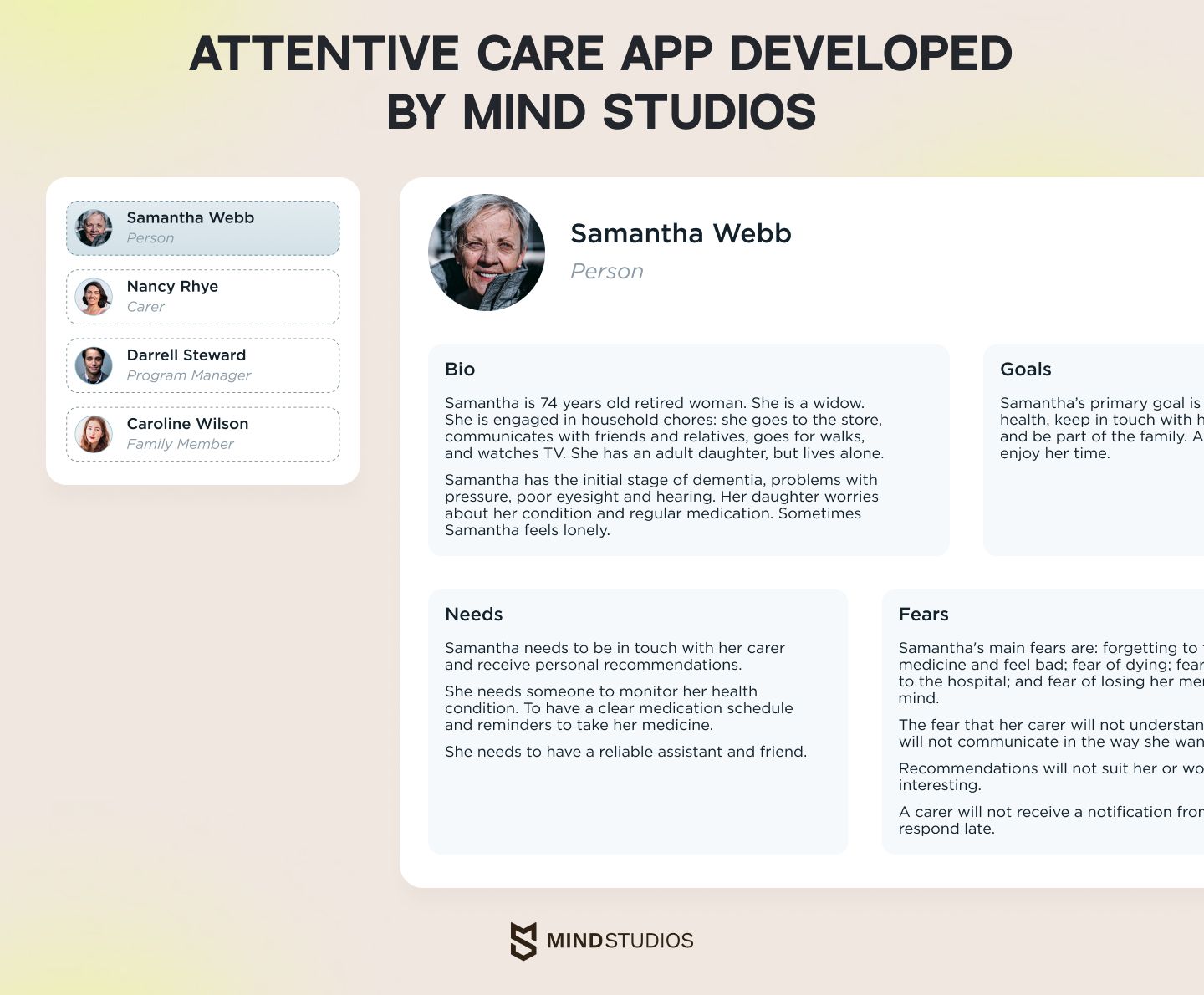
When working on Envol, we went even further. Our team conducted a survey among existing users to find out what they liked about the existing app. Then, we transformed the received data into user personas, customer journey diagrams, and wireframes for the updated app. All this helped the Envol app achieve a 40%+ retention rate to this date.
Mind Studios’ insight: Knowing your ICP not only helps select the best functionality for your app but also craft more effective and targeted marketing campaigns that speak directly to your potential users' pain points.
App idea validation
Never underestimate the idea validation stage, as it helps test your assumptions against real-time conditions.
Here is what Uri Levine, Co-founder of Waze, says on the right way to validate an idea.
“Think of a big problem, something that is worth solving, something that the world will become a better place if you solve it. And then ask yourself, ‘Who has this problem now?’ If you happen to be the only person on the planet with this problem, then I would say — go to a shrink. It’s much cheaper and much easier than building a startup. But if you think that a lot of people actually have this problem, then go and speak to those people to understand their perception of the problem and only then go and build solutions.”
After years working with clients across the globe, we created our own approach to idea validation that helped many of our clients. We usually assess your idea through market research. By understanding the current market, your competitors, and your target audience, you can validate the real potential of your app. During this step, it's important to create a value proposition and decide on your monetization strategy, too.
At Mind Studios, we strongly believe that these steps should be the groundwork for any successful diet and nutrition app, as they allow us to ensure that the final product is fully market-ready and fits users’ requirements. For more in-depth information on how we can assist you from concept to launch, you can always contact us.
Diet and nutrition app types and how to choose the right one for you
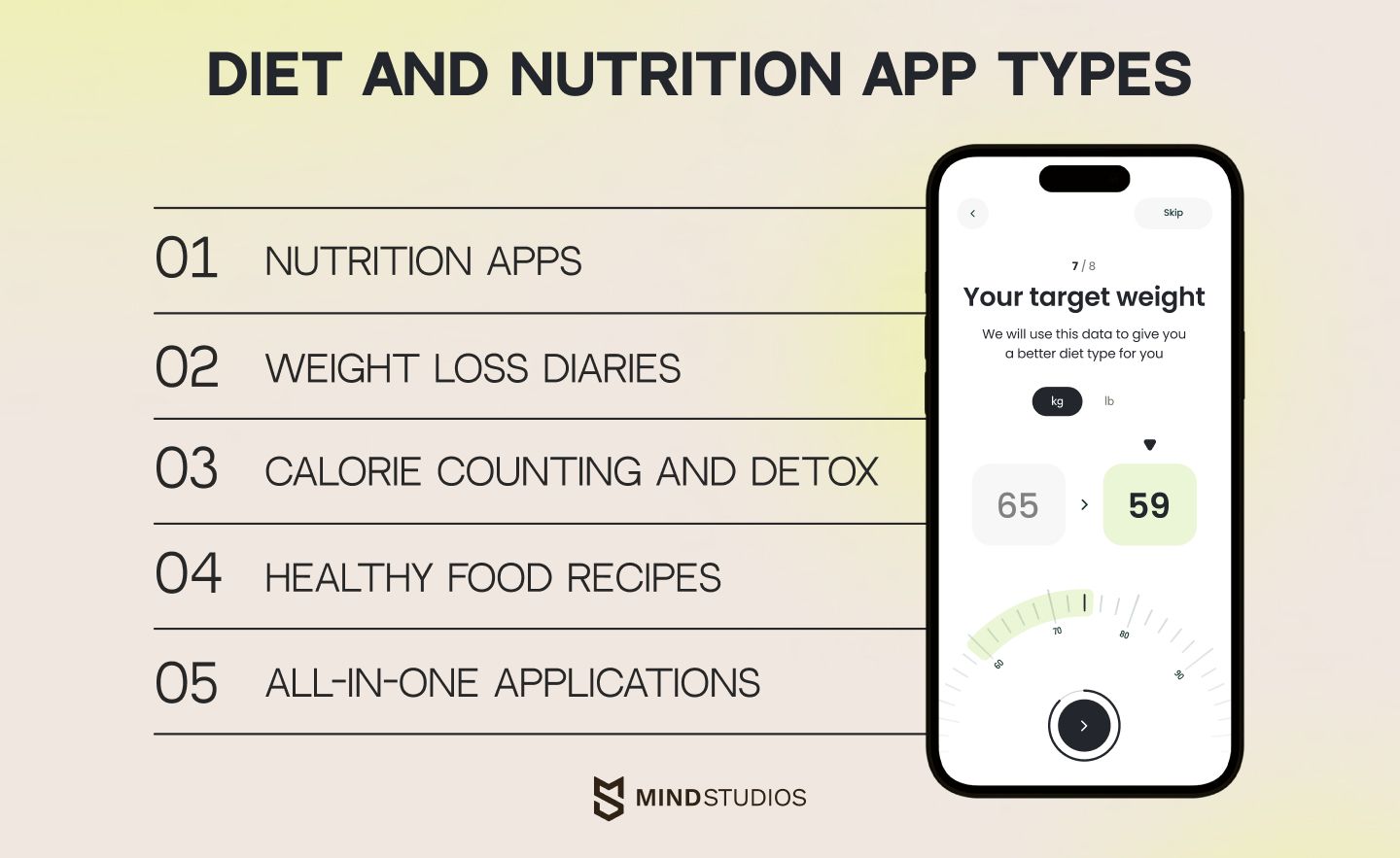
With a plethora of options available on the market, it can be a daunting task to choose the one that will actually work for your business. To simplify your decision-making, we’ll classify diet and nutrition apps into four groups and give examples of each type.
Nutrition apps
Purpose: Nutrition apps help users eat properly by tracking calories and controlling eating habits, providing tips on the nutritional value of foods.
Example: The goal of Noom Coach is not only to teach users how to eat healthy food, but also to make it a habit.
Common features:
- Calorie tracking
- Eating habit insights
- Food database
- Nutrition reports
- Integration with fitness apps
Weight loss diaries
Purpose: These applications help users lose weight without harm to health. They let users record meals and water intake, monitor calories burned and consumed, select a fitness program, and monitor its implementation.
Example: iEatBetter is an easy-to-manage weight loss tool that includes all the functionality we’ve mentioned above.
Common features:
- Calorie count
- Body weight tracking
- Water intake tracker
- Progress graphs
- Food diary
Calorie counting and detox
Purpose: Applications in this category are designed for those who monitor their diet every day, regardless of the purpose.
Example: FatSecret can autocomplete entries, scan product codes, and even recognize products by photos. The app can create graphs and compare calorie intake and nutrients throughout the week.
Common features:
- Barcode scanner
- Macro tracking
- Ingredient analysis
- Caloric breakdown by meal
- Customizable alerts
Healthy food recipes
Purpose: These applications help users create simple, tasty, and healthy dishes.
Example: PEP selects a menu for each day that includes simple, tasty, and healthy dishes. Menus are chosen based on each user’s settings, and the app provides statistics. It calculates how many calories, protein, fat, and carbohydrates a user needs based on their height, weight, and age, then distributes these across breakfast, lunch, and dinner. Calories, protein, fat, and carbohydrates in meals are calculated based on ingredients and their quantities.
Common features:
- Recipe database
- Grocery/shopping list creator
- Video tutorials
- Meal customization
- Portion size calculator
All-in-one applications
Purpose: Applications of this type combine functionalities described above for each of the four categories.
Example: MyFitnessPal has a complete set of functionality for:
- creating your own meals and exercises
- tracking essential nutrition statistics
- generating dynamic reports
- setting individual goals based on a dietary profile
- calculating the nutritional value of recipes
- handling metric and imperial measurements
Choosing the right app requires understanding the functionalities they offer and then aligning them with your objectives. For instance, if you want to focus on weight loss, you should go for an app with calorie and activity tracking.
Top features to include to your nutrition app
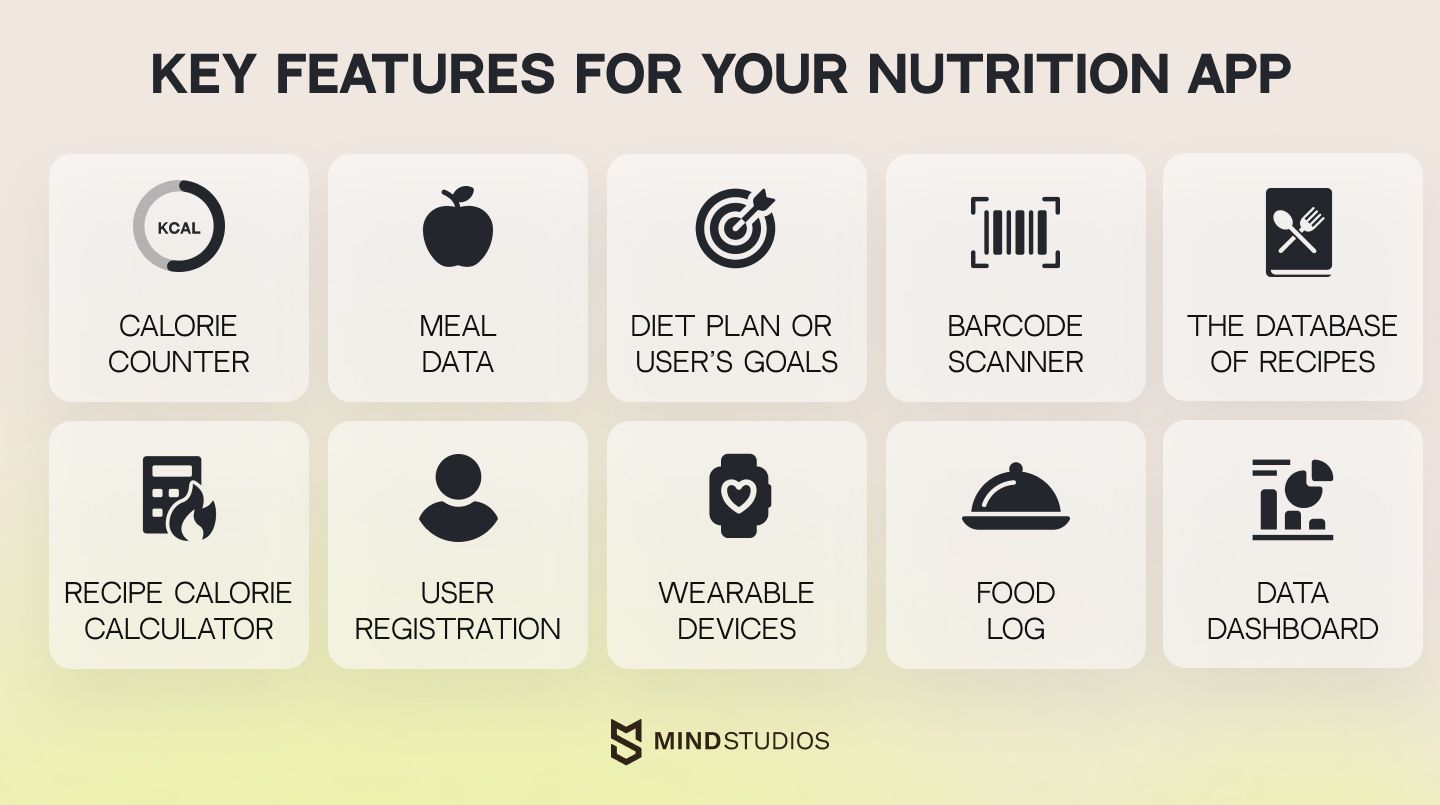
Before diet and nutrition app development , you need to understand the difference between key and additional features.
Here is a brief explanation:
While key features are the fundamental tools that allow users to interact with your app effectively and achieve their goals, additional features are not that valuable and oftentimes offer supplementary support.
We have categorized features based on their importance both to the user's journey and app functions.
Key features
| Feature | Description |
|---|---|
| Registration/Sign-in | Fundamental feature for a personalized user experience and securing user data. |
| Calorie counter | This is the basic function of a food control app that helps monitor calorie intake. |
| Meal data | Allows users to log information about every meal and analyze how well they eat every day. |
| Diet plan or user’s goals | Allows the users to make their personal diet plan or set goals for weight loss proceeding from their physical indicators. |
| Barcode scanner | Allows immediate calculation of the number of calories by scanning product barcodes. |
| The database of recipes | A sortable database of recipes by category, ingredients, calories, and level of complexity. |
| Recipe calorie calculator | Shows the calories in a particular dish and calculates the nutritional content. |
| Dashboard | Displays key user metrics like calories consumed or burned, etc. |
| Food log | Allows uploading photos and descriptions of food consumed to monitor diet closely. |
| Push notifications | Sends timely reminders about eating or starting a workout. |
| Blog | Allows users to write about their successes on a blog and read the stories of others. |
Secondary features
| Name | Description |
|---|---|
| Image recognition | Ability to recognize food in photos. |
| Calendar | It helps track eating habits over time to see patterns as well as progress. |
| Diet tips | Additional guidance useful for those who not only monitor nutrition but also want to lose weight. |
| Diet suggestions | Allows tailoring diet advice to the user's specific needs. |
| Ratings | Allows users to rate recipes and fosters community interaction. |
| Add favorite recipes | Lets users create their own recipes and share them. |
| Recipe search form | Facilitates searching recipes by keywords, ingredients, and calories. |
| Social sharing | Enables users to share their success, for example, in losing weight, with friends. |
| Shopping list | Helps users to create shopping lists on planned meals or recipes. |
| Integration with wearable devices/ activity trackers | Essential for syncing data on physical activity and health so that users receive even more personalized advice. |
Mind Studios’ insight: When you are choosing the functionality of your app, think of its scalability. As your user base grows, your diet and nutrition app must be able to handle the increased traffic and data without compromising its performance. So, when deciding on features, remember that some of them may require more complex data processing (like calorie counter or meal tracking).
You can also leverage analytics to understand how your users interact with numerous features and which are most valued by them. For example, when you see that users like a recipe database or your blog, consider refining these features and expanding them further.
Of course, if you are unsure which functionality to add to your diet and nutrition app, or you just need expert guidance on which features your user base will like, contact us at Mind Studios.
How to build a diet and nutrition mobile app: stages of development
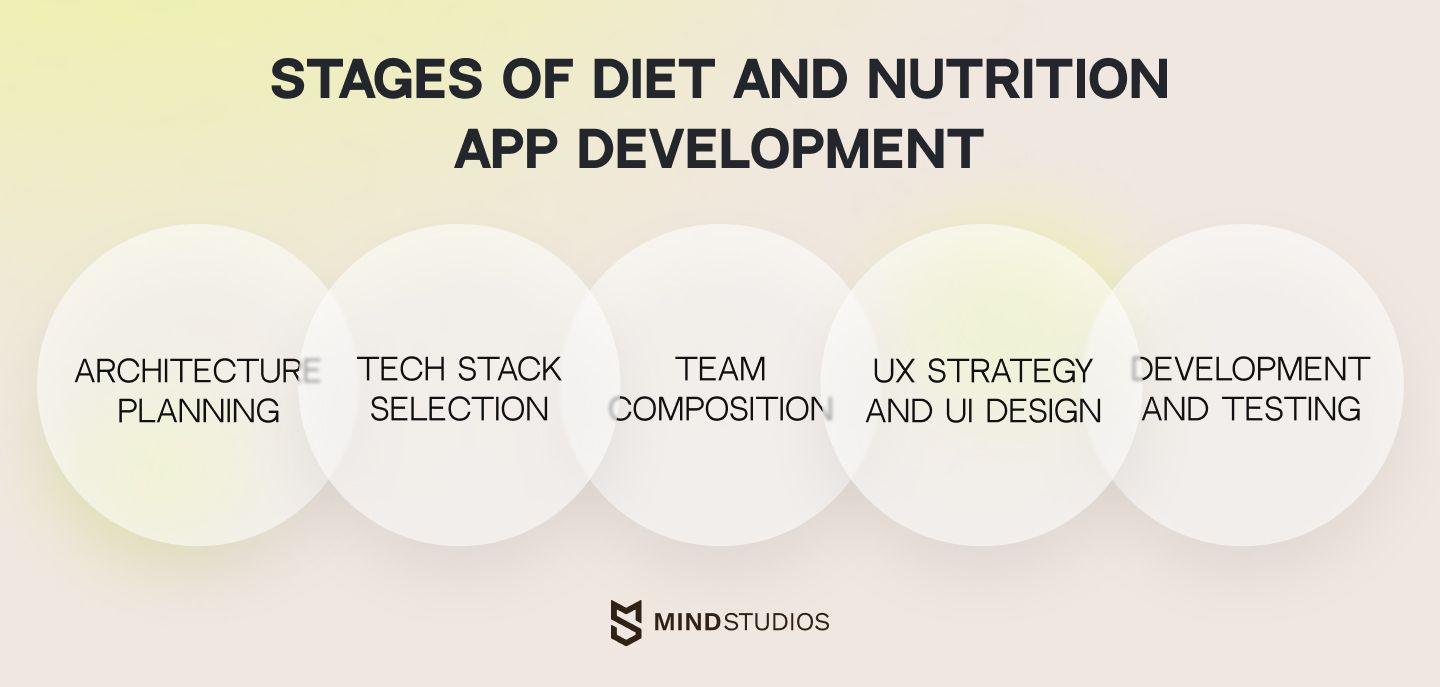
Now let’s move on to the technical aspects on how to make a nutrition app.
Creating a diet and nutrition app, especially from scratch, is a complex process requiring careful planning and skilled execution.
Here is what the process of creating such apps looks like at Mind Studios:
1. Architecture planning
Before writing any code, it’s vital to plan the architecture of your app. This step includes deciding on the overall structure of the app, as well as how each element will interact with each other. A great architecture should support the app’s functionality, scalability as well as maintenance.
At Mind Studios, we choose custom solutions for several reasons:
- Custom solutions can seamlessly integrate with third-party services, lots of wearables, and external APIs.
- Custom architecture ensures that the architecture of your app fits and supports the unique functionality and user demand.
- Such infrastructure is built with scalability in mind. Thus, it grows alongside your client base and functionality, and can handle increased loads and complex operations.
- You can tailor the security measures to protect users' sensitive data better.
2. Tech stack selection
Choosing the right tech stack, including programming languages, frameworks, and tools used during diet and nutrition app development , greatly influences your app's functionality, scalability, and performance.
At Mind Studios, we mostly focus on native development, meaning we use Objective-C or Swift for iOS and Java or Kotlin for Android. However, our tech specialists can also work with Flutter, React Native, and other technologies.
3. Team composition
An effective team can truly do wonders. The typical specialists required for the development of a diet and nutrition app include a project manager, developers, designers, and QA specialists. We usually employ agile methodology in our projects because it helps keep everyone aligned on the project.
Except for a tech team, you may also need diet and nutrition experts to guide you and advise on valuable features for such apps. Unless, of course, you’re a diet and nutrition expert yourself.
Aside from providing our clients with diet planner app development services, we also offer IT team augmentation services to expand your current team with the relevant expertise. So, don’t hesitate if you are searching for a specific skill set.
4. UX strategy and UI design
Our next step is designing your app’s user experience (UX), which includes creating a prototype of your app that allows us to visualize the user journey and makes sure the app is user-friendly and intuitive.
At Mind Studios, we strive to make interfaces not only visually appealing but functional, focusing on readability and ease of use. We also pay close attention to making an engaging visual representation of data.
Here is a great example of such UX/UI design for a healthcare app aimed at healthcare experts who provide assistance to people with disabilities or health issues like diabetes.
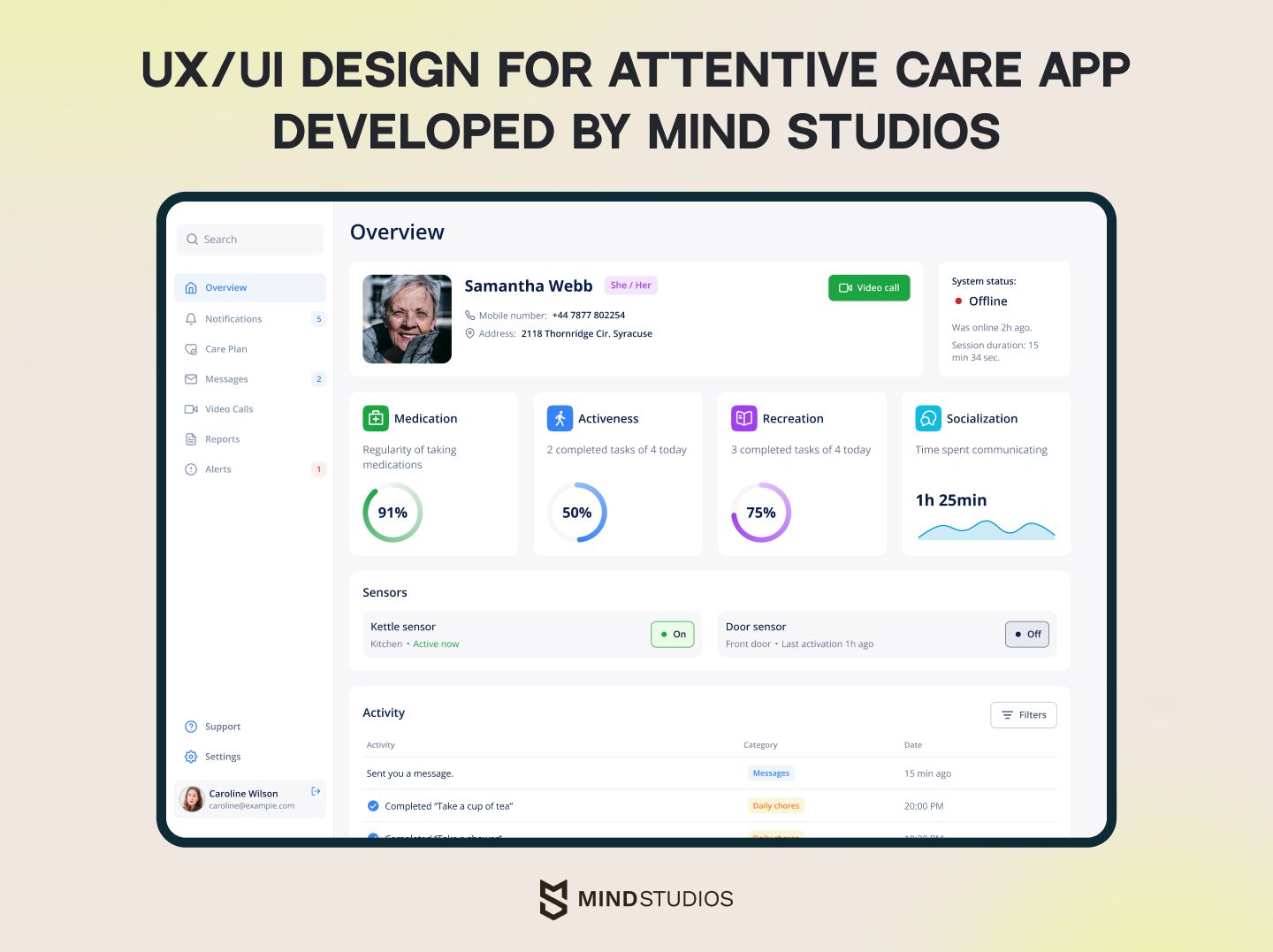
5. Development and testing
Once we've done with UX, the next step is the coding and actual diet and nutrition app development. This process is accompanied by testing to ensure your app is bug-free before it's launched.
Our team at Mind Studios uses an iterative development process, which allows for regular feedback and adjustments. We also employ testing throughout the whole development process, and not just at the end, to quickly fix any arising issue.
If the development process sounds complex to you, we are here to help you create a custom diet and nutrition app.
Key challenges when building a nutrition app
Now you have a clear understanding on how to create a diet and nutrition app. However, you should also be aware that this process may include various challenges.
Here, we have collected the most common ones together with our recommendations on how to overcome them.
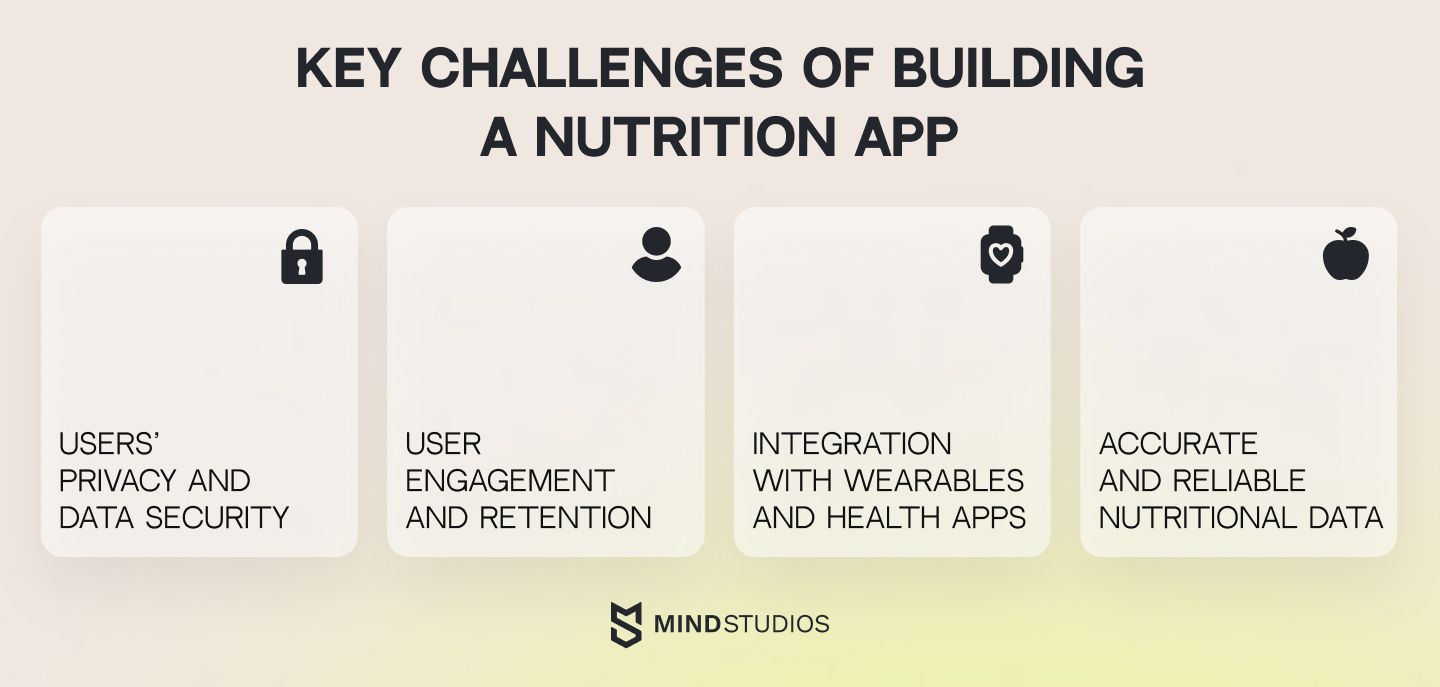
Challenge #1: Upholding users’ privacy and data security
Various strict regulations protect user data, especially health-related information, making prioritization of security a must.
Solution: When building diet and nutrition apps, we at Mind Studios always adhere to strict compliance with GDPR, HIPAA, and other related regulations. For security reasons, we employ robust encryption for data storage and transfer, secure authentication processes, including 2FA, and continuous security audits to make sure our apps are protected from unauthorized access.
Challenge #2: Sustaining user engagement and retention
Keeping users engaged is a #1 goal for any application, no matter the industry.
Solution: At Mind Studios, we study users to understand their needs and leverage various techniques to keep them engaged. For example, gamification elements such as points, badges, and progress bars can make daily nutrition tracking fun and engaging for users. Features like push notifications, milestone achievements, and goal reminders, as well as regular content updates (daily tips or adding new recipes to the database), also help keep your app fresh and engaging.
Challenge #3: Integration with wearables and health apps
If your potential users have wearable devices (smartwatch, fitness tracker, or others) or have already been using health apps on their smartphone, chances are they would like to have the ability to integrate your app with them to have a holistic view of their health.
Solution: If you are creating a custom solution, our tech team can easily help you connect your app with popular platforms like Google Fit or Apple HealthKit with the help of APIs. If you want to seamlessly integrate with lesser known brands, it may require more work, but it is still manageable.
Challenge #4: Ensuring accurate and reliable nutritional data
The core of any nutrition app is a nutritional information database, which must be accurate and comprehensive.
Solution: To create a truly reliable app, you need to partner with a nutritionist/dietitian, industry experts, or get help from reputable sources like USDA's FoodData Central to ensure the data you use is scientifically proven.
When we worked on the Horse Side Vet Guide (HSVG) project, a comprehensive knowledge base of equine health information, we closely collaborated with our client Dr. Thal, an equine veterinarian and horseman. This helped us create a remarkable app that helps horse owners worldwide treat their horses correctly. It soon transformed into the most highly-rated equine health app in the world.
Ways to earn money from your app
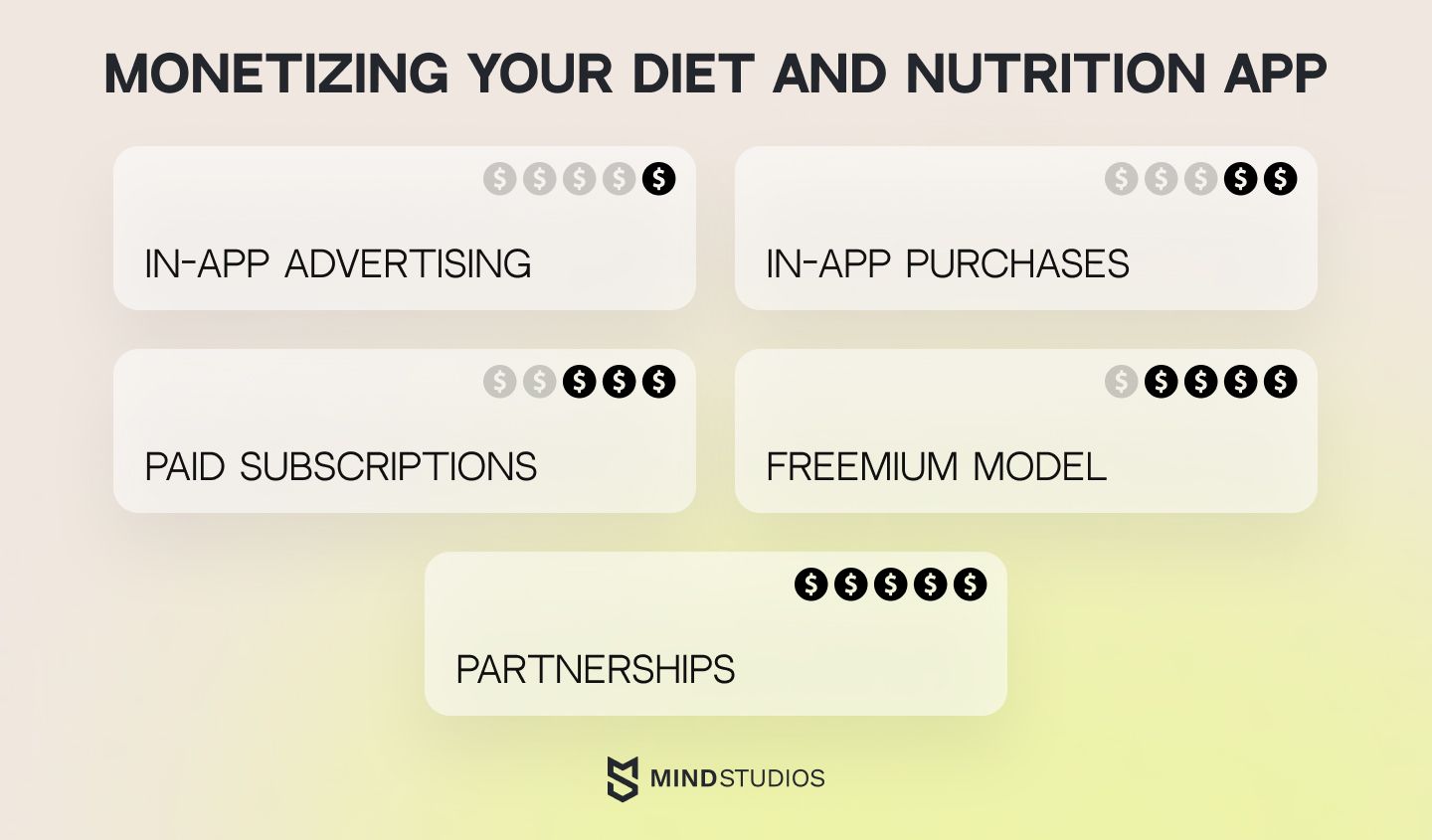
There are some basic ways to make money with food and fitness apps.
- In-app advertising. Built-in advertising works by displaying ads in a designated space in the interface. App owners get paid for display ads based on the number of shows or clicks. This method is ideal for applications that are frequently used.
- In-app purchases. In-app purchases allow users to buy additional features or bonuses. However, they require loyal followers willing to pay money for additional nutrition app features.
- Paid subscriptions have recently gained popularity and are another option for monetizing applications. Users of subscription applications pay on a monthly/yearly basis to access the application. Localytics claims that the subscription model is more profitable than other monetization models.
- The freemium model gives users free access to basic functionality while full functionality is paid.
- Partnerships. Another way to gain money is to partner with other services and get a fee in exchange for advertising or promoting their services or goods in your app.
Of course, you aren’t limited to these methods. However, choosing a monetization model is one of the most important decisions you’ll make while developing your app, and the right method will depend on the type of app, its functionality, your target users, and other factors.
Cost to develop a diet app for iOS and Android
A diet and nutrition app can’t be a standardized solution; therefore, the question of how much it costs to develop an app has to be answered individually for each specific case.
The main factors determining the price include the idea itself, the functionality you need to implement, the technologies you choose, the design of the app, and the operating system your app will be created for.
We can say that roughly, the minimum cost of diet and nutrition tracking mobile app development will be about $49,400. You can read more about how to estimate mobile development expenses in our article on estimating the cost of a mobile app.
Conclusion
In this article, we tried to give a detailed answer to the question ‘How to build a diet and nutrition app?’ As the sector continues to expand, the potential for creating effective diet and nutrition apps has never been greater.
Building such apps, however, requires a careful and strategic approach. But worry not. Mind Studios can help you create impactful health apps that are both functional and transformative.
Whether you need to refine an existing app or start one from scratch, we are here to help. Contact us if you need expert assistance in bringing your vision to life and creating diet and nutrition apps to enhance people's lives and foster healthier communities globally.
You may also be interested in: How AI is Changing Mobile App Development - Mind Studios

